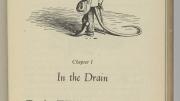With the extensive collection of children’s books donated by Peter J. Solomon ’60, M.B.A. ’63, the newly renovated Houghton Library could have opened an exhibit of the genre’s “greatest hits.” Among other treasures, Solomon’s collection includes first editions of Lewis Carroll’s Alice’s Adventures in Wonderland and Beatrix Potter’s Peter Rabbit. But in “Animals Are Us,” an exhibit open in the library through January 7, 2022, guest curators H. Nichols B. Clark ’69, founding director and chief curator (emeritus) of The Eric Carle Museum of Picture Book Art, and Meghan Melvin, a curator at the Museum of Fine Arts, Boston, aimed for a broader perspective.
The new exhibit—the first in a newly renovated Houghton Library—explores anthropomorphism in children’s literature, celebrating Solomon’s collection while inviting guests to engage with the cultural influence, potential, and pitfalls of books for kids. “While we welcome feelings of delight and nostalgia,” writes Fearrington librarian of Houghton Library Thomas Hyry in an introduction to the collection, “this exhibition—and children’s literature in general—quickly reveals itself as a much more potent source for understanding our collective past and present.”
Visitors typically start at the first section, “Beginnings,” which examines the introduction of children’s literature as a genre. Featuring German Popular Stories by the Brothers Grimm and other early classics, the section traces some of the staples of children’s literature—talking animals, nursery rhymes, colorful pictures—to their origin. This trajectory of growth continues in “Fables,” with original works from Jean de La Fontaine and Rudyard Kipling. On the wall overlooking the display is “Drawing of a Lion,” a work by Alexander Calder. “We don’t want people to miss what’s hanging on the walls,” Melvin said—where many of the exhibit’s unique features hang.
Much of the exhibit’s intrigue comes from the through-line the curators construct from some of the oldest and most famous children’s works to contemporary stories. In the “Rhymes” section, which follows the progression of rhyming in children’s literature, Hey Diddle Diddle and Baby Bunting by Randolph Caldecott sits beside After the Fall: How Humpty Dumpty Got Back Up Again—a contemporary play on a classic by author and illustrator Dan Santat (who won the Caldecott Medal for illustration in 2015). Examples like this are an invitation, Melvin says, “to think about books visitors might be very familiar with, and very fond of…through a new lens.”
A more critical look comes out most clearly in the exhibit’s “Controversy” section, which engages with cultural appropriation, racism, and religious proselytization in children’s literature. In the display case, Helen Bannerman’s The Story of Little Black Sambo—a book criticized for its depictions of racial stereotypes—lies alongside Sam and the Tigers: A New Telling of Little Black Sambo by African-American writer Julian Lester. Both curators acknowledged that while children’s books can offend and cause harm, the best way to engage with the questions they bring up is by confronting them directly. “Those books don’t need to go away,” Melvin says, “but maybe how we talk about them and how we look at them should change.”
Some controversies on display are less consequential. In E.B. White’s original version of Stuart Little, an early edition of which was donated by Solomon, Stuart was described as being “born” into the human Little family. This description proved scandalous at the time, and the wording was later adapted to say that he “arrived.”
The “Endurance,” “Adaptation,” and “Innovation” sections follow, showing how and why children’s literature sticks so firmly in the popular imagination—and where the genre is going, with technology and broader cultural perspectives playing an increasing role. The exhibit ends with a selection called “Restoring Dignity,” devoted to the efforts of writers to represent Indigenous peoples in children’s literatures in ways that are respectful rather than stereotypical and demeaning, as it often was in generations before. After a library renovation that added accessibility features to a rather closed-off space, the exhibit continues the theme of belonging. “What it does,” said Clark, “is it gives the individual a point of entry.”









